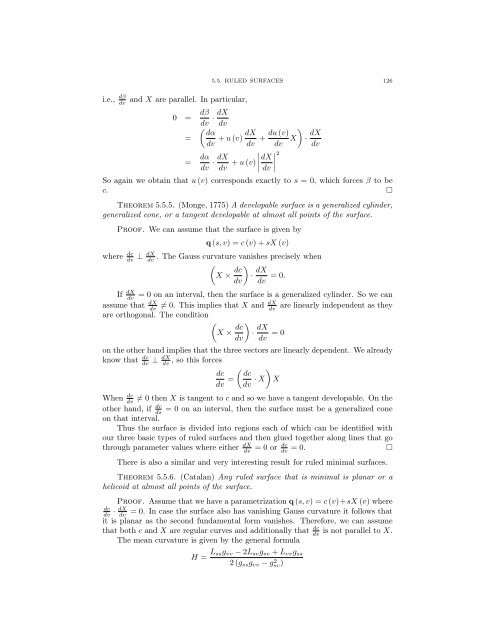Lecture Notes for 120 - UCLA Department of Mathematics
Lecture Notes for 120 - UCLA Department of Mathematics
Lecture Notes for 120 - UCLA Department of Mathematics
Create successful ePaper yourself
Turn your PDF publications into a flip-book with our unique Google optimized e-Paper software.
i.e., d dv<br />
and X are parallel. In particular,<br />
0 = d dv · dX<br />
dv<br />
=<br />
5.5. RULED SURFACES 126<br />
✓ d↵ dX<br />
+ u (v)<br />
dv dv<br />
= d↵<br />
dv · dX dX<br />
+ u (v)<br />
dv dv<br />
◆<br />
du (v)<br />
+<br />
dv<br />
X · dX<br />
dv<br />
So again we obtain that u (v) corresponds exactly to s =0, which <strong>for</strong>ces to be<br />
c. ⇤<br />
Theorem 5.5.5. (Monge, 1775) A developable surface is a generalized cylinder,<br />
generalized cone, or a tangent developable at almost all points <strong>of</strong> the surface.<br />
Pro<strong>of</strong>. We can assume that the surface is given by<br />
where dc<br />
dv ? dX<br />
dv<br />
If dX<br />
dv<br />
q (s, v) =c (v)+sX (v)<br />
. The Gauss curvature vanishes precisely when<br />
✓<br />
X ⇥ dc ◆<br />
· dX<br />
dv dv =0.<br />
=0on an interval, then the surface is a generalized cylinder. So we can<br />
assume that dX<br />
dX<br />
dv<br />
6=0. This implies that X and<br />
dv<br />
are linearly independent as they<br />
are orthogonal. The condition ✓<br />
X ⇥ dc ◆<br />
· dX<br />
dv dv =0<br />
2<br />
on the other hand implies that the three vectors are linearly dependent. We already<br />
know that dc<br />
dv ? dX<br />
dv ,sothis<strong>for</strong>ces<br />
✓ ◆<br />
dc dc<br />
dv = dv · X X<br />
6=0then X is tangent to c and so we have a tangent developable. On the<br />
other hand, if dc<br />
ds<br />
=0on an interval, then the surface must be a generalized cone<br />
on that interval.<br />
Thus the surface is divided into regions each <strong>of</strong> which can be identified with<br />
our three basic types <strong>of</strong> ruled surfaces and then glued together along lines that go<br />
When dc<br />
dv<br />
through parameter values where either dX<br />
dv<br />
dc<br />
=0or<br />
dv =0.<br />
There is also a similar and very interesting result <strong>for</strong> ruled minimal surfaces.<br />
Theorem 5.5.6. (Catalan) Any ruled surface that is minimal is planar or a<br />
helicoid at almost all points <strong>of</strong> the surface.<br />
Pro<strong>of</strong>. Assume that we have a parametrization q (s, v) =c (v)+sX (v) where<br />
dc<br />
dv · dX<br />
dv<br />
=0. In case the surface also has vanishing Gauss curvature it follows that<br />
it is planar as the second fundamental <strong>for</strong>m vanishes. There<strong>for</strong>e, we can assume<br />
that both c and X are regular curves and additionally that dc<br />
dv<br />
is not parallel to X.<br />
The mean curvature is given by the general <strong>for</strong>mula<br />
H = L ssg vv 2L sv g sv + L vv g ss<br />
2(g ss g vv gsv)<br />
2<br />
⇤
















